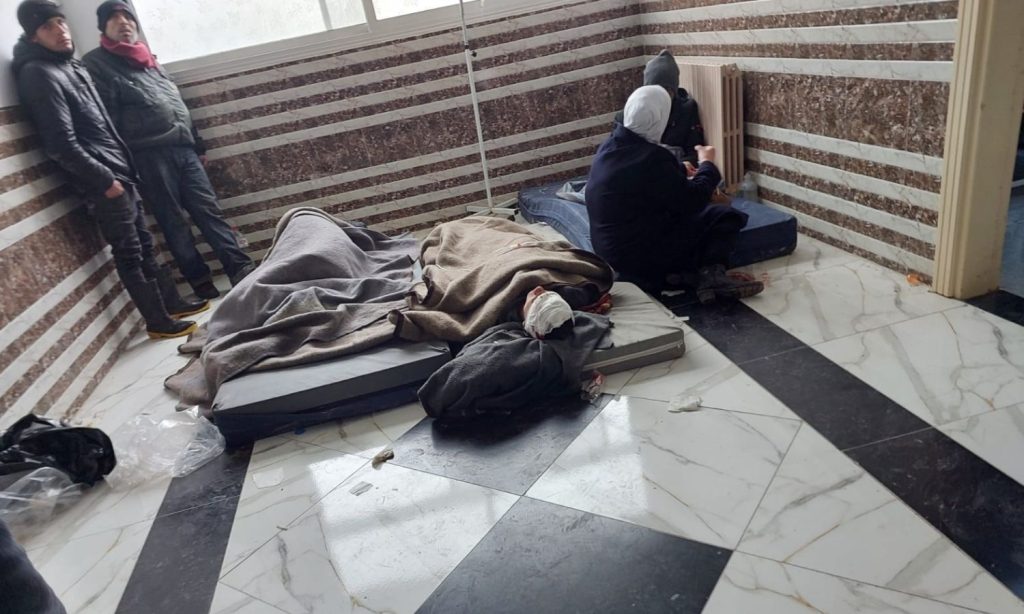Syrian hospitals and medical centers responded to the effects of the earthquake that struck areas of Syria with a maximum capacity of equipment and cadres, despite the large deficit suffered by the medical sector in general.
For years, all Syrian governorates have been suffering from a severe crisis in the medical sector as a result of the loss of many items of medicines and medical equipment owing, on the one hand, to the lack of support for the facilities and the absence of trained and specialized medical personnel in numbers that meet the region’s needs on the other.
Maram al-Sheikh, the Minister of Health of the Syrian Interim Government (SIG) in control of areas in the Aleppo countryside, told Enab Baladi that hospitals in the region are operating at maximum capacity amid a declared state of emergency and alert, including emergency systems, hospitals, and the entirety of the medical personnel.
Al-Sheikh explained that the magnitude of the disaster is considerable amid a very large number of casualties, making all hospitals overcrowded while already suffering from a significant shortage of materials, especially in cases of traumatic injury. The health sector had shown flexibility as much as possible by dealing with the number of earthquake casualties, he said.
A traumatic injury is a severe physical injury that occurs suddenly, requiring immediate medical attention. This type of injury must be dealt with first in emergency clinics and with a later referral to a specialist doctor.
Imad Zahran, the director of the media office in the Idlib Health Directorate, told Enab Baladi that the sky-high number of injuries and deaths and the destruction of entire neighborhoods in most cities had forced hospitals to operate significantly above capacity.
The researcher at the Omran Center for Strategic Studies residing in northwestern Syria, Ali Abdul Majeed, told Enab Baladi that all hospitals continue to receive the injured. However, any hospital that includes only two beds for patients, for example, accommodates eight patients in one room, most of whom are lying on the floor.
In terms of logistics, Abdul Majeed explained that there are very few diagnostic medical imaging equipment and other medical services, and health facilities in the region already suffer from a major shortage amid the absence of support provided to the medical sector.
People affected by the earthquake that struck Idlib on 6 February 2023 at the Salqin Hospital (Ali Abdul Majeed)
In regime-held areas, the Ministry of Health indicated that it had sent a number of medical convoys from the Health Directorates of Damascus, Damascus countryside, Quneitra, Homs, and Tartus, to Aleppo and Latakia. It also dispatched 28 ambulances, seven mobile clinics, and four trucks loaded with medicines and surgical and emergency supplies.
People affected by the earthquake that struck the city of Aleppo on 6 February 2023 (Aleppo University Hospital)
The search continues, Appeals for assistance
Abdul Hamid Qatini, a media figure in the Syria Civil Defense (SCD) team, told Enab Baladi that the SCD teams are still continuing the search and rescue operations in the areas and buildings destroyed by the earthquake in northwestern Syria in catastrophic conditions; such operations are conducted during a blizzard and extremely low temperatures.
Qatini explained that more than 2000 SCD volunteers were deployed in all regions of northern Syria to conduct search and rescue operations amid insufficient search mechanisms and tools, which forced the SCD to forward appeals to all organizations operating in the region and civilians to assist in facilitating the teams’ work.
More than 1700 deaths
At the dawn of Monday, 6 February, regions and provinces of southeastern Turkey experienced a 7.8-degree earthquake on the Richter scale, 7 kilometers below the ground surface. Its epicenter was the Turkish province of Kahramanmaraş and had also affected the governorates of Idlib, Aleppo, Latakia, and Hama in Syria.
The Syria Civil Defense (SCD) team said in its latest data that the number of deaths from the earthquake in northwestern Syria has exceeded 900 and that the number is on the rise. The number of injuries crossed the threshold of 2300 wounded civilians. Hundreds of families also remain under rubble amid the complete collapse of more than 150 buildings, and the partial destruction of another 330 buildings, and thousands of fractured buildings.
For its part, the Syrian regime’s Ministry of Health has reported in its latest statistics 812 deaths and 1449 injuries in the governorates of Aleppo, Latakia, Hama, and Tartus, in addition to recording collapse and cracks in dozens of residential buildings.











